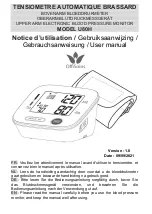
•
Off—Produces good results for most content.
•
Auto—Automatically adjusts LCD scanning to eliminate tearing between rows in a
video wall that is displaying fast-moving video.
•
Odd—Manually selects the best scan behavior for the odd rows of display panels in a
video wall, for example, rows 1, 3, or 5.
•
Even—Manually selects the best scan behavior for the even rows of display panels in
a video wall, for example, rows 2, 4, or 6.
•
Frame—Enables or disables frame compensation to join the edges of adjacent display
panels in a video wall together. This can compensate for the gap between the display
panels.
When enabled, moving objects in a video move behind the gap. This allows for better
continuity of motion across the video wall and is suitable for moving images. When
disabled, joints between the display panels are shown. This is suitable for still images.
•
Matrix X—Specifies the number of columns in a video wall.
•
Matrix Y—Specifies the number of rows in a video wall.
•
Division X—Specifies the horizontal position (column) of a display panel in a video wall.
•
Division Y—Specifies the vertical position (row) of a display panel in a video wall.
•
IR Mode—If the remote control should control all display panels in a video wall, select All.
If the remote control should control one display panel at a time, select Target. To use this
option, RS485 cables must be connected to the display panel.
•
Recipient ID—Selects which display panel is controlled by the remote control. To use this
feature, set the IR Mode to Target. RS485 cables must be connected to the display panel.
•
Auto Video Wall Setup—Automatically sets the monitor IDs for all display panels in a
video wall. To use this option, RS485 cables must be connected to the display panel.
Updating Anti-tearing settings
If displaying fast-moving video, the Anti-tearing feature can eliminate tearing artifacts between
adjacent rows of display panels in an array.
When enabling or disabling the Anti-tearing feature, or if changing the Anti-tearing settings, you must
power cycle the display panels in the array for the changes to take effect.
After the power cycle is complete, to achieve color matching in the array, you must readjust some
image settings on the display panels. To learn how to adjust image settings, see the user manual.
1. On the remote control or keypad, press MENU.
2. Select Advanced Settings > Multi-Display Control.
3. Use the arrows to turn on the Video Wall setting.
4. Select any of the following options.
•
Off—Produces good results for most content.
•
Auto—Automatically adjusts LCD scanning to eliminate tearing between rows in an array
displaying fast-moving video.
•
Odd—Manually selects the best scan behavior for the odd rows of display panels in an
array, for example, rows 1, 3, or 5.
•
Even—Manually selects the best scan behavior for the even rows of display panels in an
array, for example, rows 2, 4, or 6.
Updating display settings
FHD553-XE-R and FHD553-XE-HR LCD Panels User Guide
43
020-001198-04 Rev. 1 (01-2019)
Copyright
©
2019 Christie Digital Systems USA, Inc. All rights reserved.
Содержание 135-008109-01
Страница 1: ...User Guide 020 001198 04 FHD553 XE R and FHD553 XE HR LCD Panels ...
Страница 58: ......
















































